BRCA1 Polyclonal Antibody
- Catalog No.:YT0519
- Applications:WB;IHC;IF;ELISA
- Reactivity:Human;Rat
- Target:
- BRCA1
- Fields:
- >>Platinum drug resistance;>>Homologous recombination;>>Fanconi anemia pathway;>>Ubiquitin mediated proteolysis;>>PI3K-Akt signaling pathway;>>MicroRNAs in cancer;>>Breast cancer
- Gene Name:
- BRCA1
- Protein Name:
- Breast cancer type 1 susceptibility protein
- Human Gene Id:
- 672
- Human Swiss Prot No:
- P38398
- Mouse Swiss Prot No:
- P48754
- Rat Gene Id:
- 497672
- Rat Swiss Prot No:
- O54952
- Immunogen:
- The antiserum was produced against synthesized peptide derived from human BRCA1. AA range:1391-1440
- Specificity:
- BRCA1 Polyclonal Antibody detects endogenous levels of BRCA1 protein.
- Formulation:
- Liquid in PBS containing 50% glycerol, 0.5% BSA and 0.02% sodium azide.
- Source:
- Polyclonal, Rabbit,IgG
- Dilution:
- WB 1:500 - 1:2000. IHC 1:100 - 1:300. IF 1:200 - 1:1000. ELISA: 1:5000. Not yet tested in other applications.
- Purification:
- The antibody was affinity-purified from rabbit antiserum by affinity-chromatography using epitope-specific immunogen.
- Concentration:
- 1 mg/ml
- Storage Stability:
- -15°C to -25°C/1 year(Do not lower than -25°C)
- Other Name:
- BRCA1;RNF53;Breast cancer type 1 susceptibility protein;RING finger protein 53
- Molecular Weight(Da):
- 208kD
- Background:
- This gene encodes a nuclear phosphoprotein that plays a role in maintaining genomic stability, and it also acts as a tumor suppressor. The encoded protein combines with other tumor suppressors, DNA damage sensors, and signal transducers to form a large multi-subunit protein complex known as the BRCA1-associated genome surveillance complex (BASC). This gene product associates with RNA polymerase II, and through the C-terminal domain, also interacts with histone deacetylase complexes. This protein thus plays a role in transcription, DNA repair of double-stranded breaks, and recombination. Mutations in this gene are responsible for approximately 40% of inherited breast cancers and more than 80% of inherited breast and ovarian cancers. Alternative splicing plays a role in modulating the subcellular localization and physiological function of this gene. Many alternatively spliced transcript varian
- Function:
- disease:Defects in BRCA1 are a cause of genetic susceptibility to breast cancer (BC) [MIM:113705, 114480]. BC is an extremely common malignancy, affecting one in eight women during their lifetime. A positive family history has been identified as major contributor to risk of development of the disease, and this link is striking for early-onset breast cancer. Mutations in BRCA1 are thought to be responsible for 45% of inherited breast cancer. Moreover, BRCA1 carriers have a 4-fold increased risk of colon cancer, whereas male carriers face a 3-fold increased risk of prostate cancer. Cells lacking BRCA1 show defects in DNA repair by homologous recombination.,disease:Defects in BRCA1 are a cause of genetic susceptibility to ovarian cancer [MIM:113705].,disease:Defects in BRCA1 are a cause of susceptibility to familial breast-ovarian cancer type 1 (BROVCA1) [MIM:604370]. Mutations in BRCA1 are
- Subcellular Location:
- Nucleus . Chromosome . Cytoplasm . Localizes at sites of DNA damage at double-strand breaks (DSBs); recruitment to DNA damage sites is mediated by ABRAXAS1 and the BRCA1-A complex (PubMed:26778126). Translocated to the cytoplasm during UV-induced apoptosis (PubMed:20160719). .; [Isoform 3]: Cytoplasm.; [Isoform 5]: Cytoplasm .
- Expression:
- Isoform 1 and isoform 3 are widely expressed. Isoform 3 is reduced or absent in several breast and ovarian cancer cell lines.
Fangchinoline suppresses conjunctival melanoma by directly binding FUBP2 and inhibiting the homologous recombination pathway. Cell Death & Disease Cell Death Dis. 2021 Apr;12(4):1-11 WB Mouse,Human A375 cell-xenograft CM-AS16 cell
Antitumor effects and mechanisms of olaparib in combination with carboplatin and BKM120 on human triple‑negative breast cancer cells. ONCOLOGY REPORTS 2018 Sep 20 IF Human CAL51cell
LncRNA H19 Regulates Breast Cancer DNA Damage Response and Sensitivity to PARP Inhibitors via Binding to ILF2. Xinghua Han IF,WB Human MCF-7 cell,SUM149 cell
- June 19-2018
- WESTERN IMMUNOBLOTTING PROTOCOL
- June 19-2018
- IMMUNOHISTOCHEMISTRY-PARAFFIN PROTOCOL
- June 19-2018
- IMMUNOFLUORESCENCE PROTOCOL
- September 08-2020
- FLOW-CYTOMEYRT-PROTOCOL
- May 20-2022
- Cell-Based ELISA│解您多样本WB检测之困扰
- July 13-2018
- CELL-BASED-ELISA-PROTOCOL-FOR-ACETYL-PROTEIN
- July 13-2018
- CELL-BASED-ELISA-PROTOCOL-FOR-PHOSPHO-PROTEIN
- July 13-2018
- Antibody-FAQs
- Products Images
.jpg)
- Bao, K., Li, Y., Wei, J. et al. Fangchinoline suppresses conjunctival melanoma by directly binding FUBP2 and inhibiting the homologous recombination pathway. Cell Death Dis 12, 380 (2021).
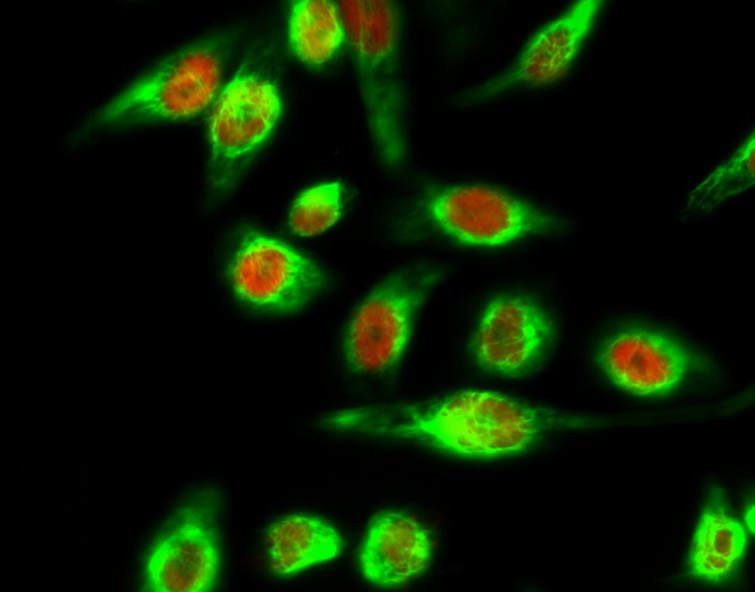
- Immunofluorescence analysis of Hela cell. 1,BRCA1 Polyclonal Antibody(green) was diluted at 1:200(4° overnight). (red) was diluted at 1:200(4° overnight). 2, Goat Anti Rabbit Alexa Fluor 488 Catalog:RS3211 was diluted at 1:1000(room temperature, 50min). Goat Anti Mouse Alexa Fluor 594 Catalog:RS3608 was diluted at 1:1000(room temperature, 50min).
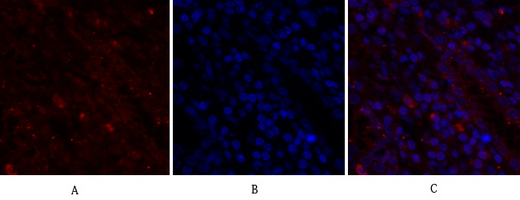
- Immunofluorescence analysis of human-stomach tissue. 1,BRCA1 Polyclonal Antibody(red) was diluted at 1:200(4°C,overnight). 2, Cy3 labled Secondary antibody was diluted at 1:300(room temperature, 50min).3, Picture B: DAPI(blue) 10min. Picture A:Target. Picture B: DAPI. Picture C: merge of A+B
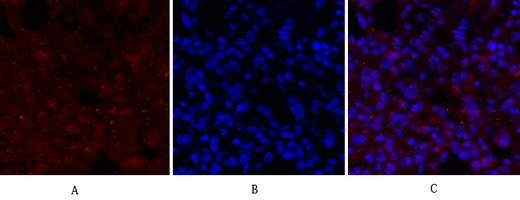
- Immunofluorescence analysis of rat-lung tissue. 1,BRCA1 Polyclonal Antibody(red) was diluted at 1:200(4°C,overnight). 2, Cy3 labled Secondary antibody was diluted at 1:300(room temperature, 50min).3, Picture B: DAPI(blue) 10min. Picture A:Target. Picture B: DAPI. Picture C: merge of A+B
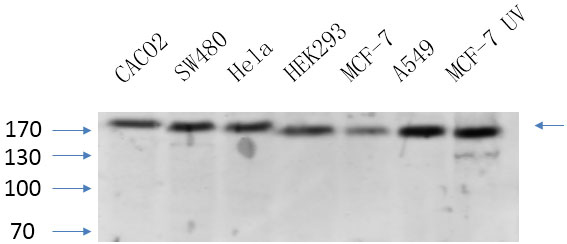
- Western Blot analysis of various cells using primary antibody diluted at 1:1000(4°C overnight). Secondary antibody:Goat Anti-rabbit IgG IRDye 800( diluted at 1:5000, 25°C, 1 hour). Cell lysate was extracted by Minute™ Plasma Membrane Protein Isolation and Cell Fractionation Kit(SM-005, Inventbiotech,MN,USA).

- Immunohistochemical analysis of paraffin-embedded Human-uterus tissue. 1,BRCA1 Polyclonal Antibody was diluted at 1:200(4°C,overnight). 2, Sodium citrate pH 6.0 was used for antibody retrieval(>98°C,20min). 3,Secondary antibody was diluted at 1:200(room tempeRature, 30min). Negative control was used by secondary antibody only.
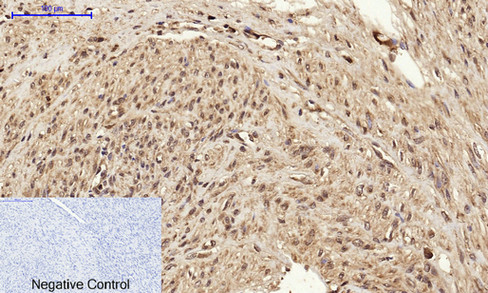
- Immunohistochemical analysis of paraffin-embedded Human-uterus-cancer tissue. 1,BRCA1 Polyclonal Antibody was diluted at 1:200(4°C,overnight). 2, Sodium citrate pH 6.0 was used for antibody retrieval(>98°C,20min). 3,Secondary antibody was diluted at 1:200(room tempeRature, 30min). Negative control was used by secondary antibody only.
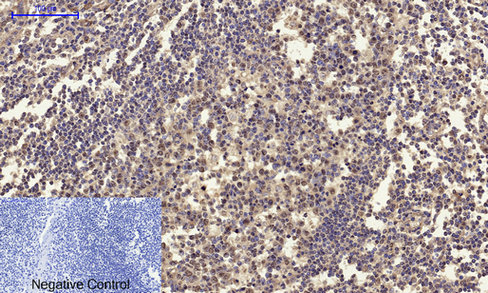
- Immunohistochemical analysis of paraffin-embedded Human-Tonsil tissue. 1,BRCA1 Polyclonal Antibody was diluted at 1:200(4°C,overnight). 2, Sodium citrate pH 6.0 was used for antibody retrieval(>98°C,20min). 3,Secondary antibody was diluted at 1:200(room tempeRature, 30min). Negative control was used by secondary antibody only.

- Western Blot analysis of various cells using BRCA1 Polyclonal Antibody diluted at 1:1000
.jpg)
- Western Blot analysis of HT29 cells using BRCA1 Polyclonal Antibody diluted at 1:1000

- Immunohistochemical analysis of paraffin-embedded Human stomach. 1, Antibody was diluted at 1:100(4° overnight). 2, High-pressure and temperature EDTA, pH8.0 was used for antigen retrieval. 3,Secondary antibody was diluted at 1:200(room temperature, 30min).
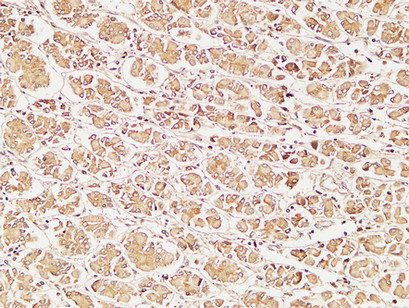
- Immunohistochemical analysis of paraffin-embedded Human stomach. 1, Antibody was diluted at 1:100(4° overnight). 2, High-pressure and temperature EDTA, pH8.0 was used for antigen retrieval. 3,Secondary antibody was diluted at 1:200(room temperature, 30min).
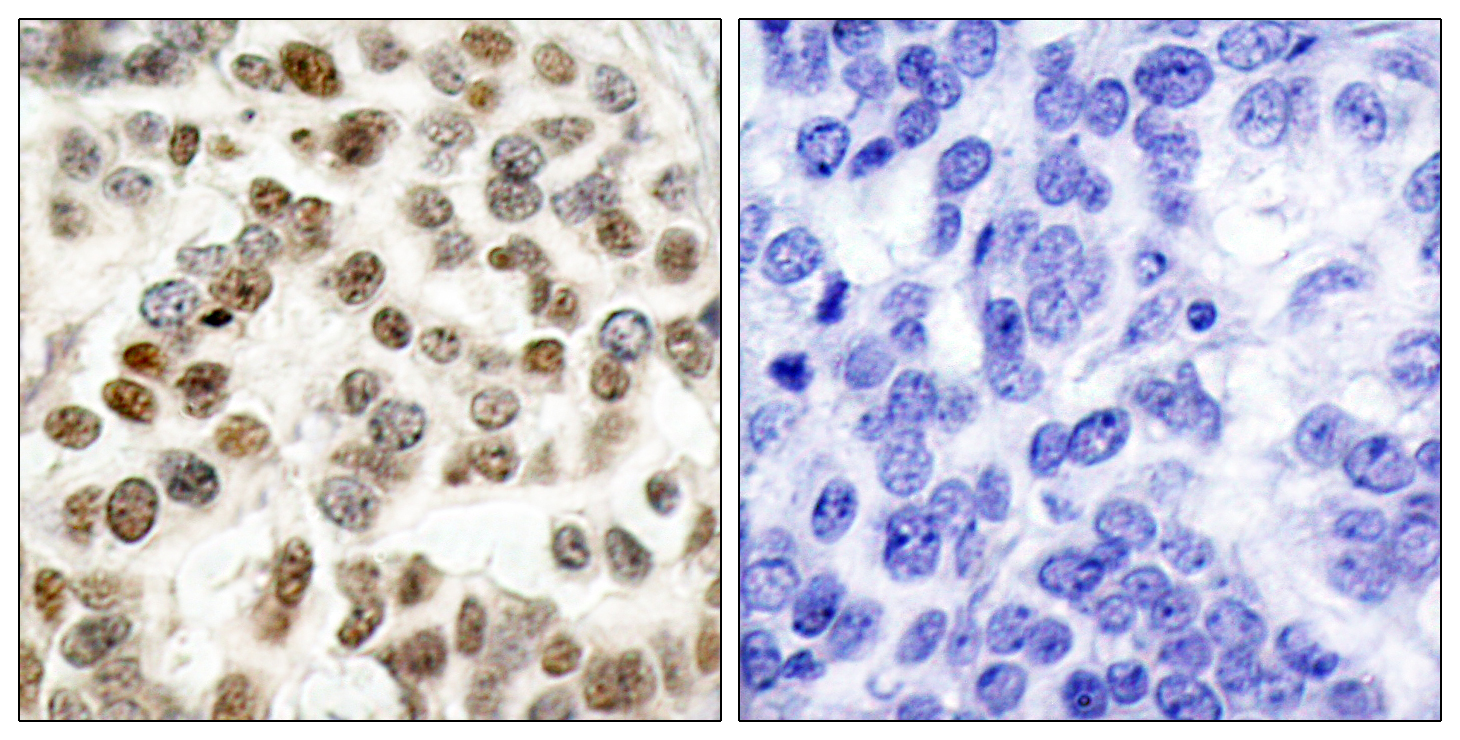
- Immunohistochemistry analysis of paraffin-embedded human breast carcinoma tissue, using BRCA1 Antibody. The picture on the right is blocked with the synthesized peptide.



